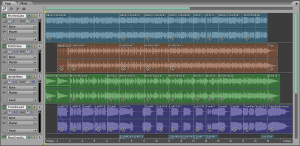What Are The Secrets of the Audio Mastering Mystics?
Have you ever seen the liner notes of an album proclaim that the CD was recorded at one place, mixed at another, and then mastered at yet a third place? Have you ever wondered what “mastering” is? You’re not alone. The true masters at mastering (see what I did there?…OK, moving on:)) guard their mastering tips and techniques like gold.
Recording magazines frequently run articles on mastering audio, revealing just enough information to sometimes convince folks into not trying it home. Mastering engineers have gone through years of highly specialized training and have been anointed in clandestine ceremonies where they are sworn to secrecy on pain of death. Or maybe I’m getting that confused with some other secret society? It doesn’t matter. What matters is that the message is almost always something like “mastering audio is such a subtle, complex, and downright dangerous thing to do without the right training and tools that you’d be a fool to attempt it yourself, unless you have the tattoo.” Sorry, that last part was another kind of secret society. I keep getting them mixed up for some reason.
Here is what is generally known about the ancient and mystical art of mastering. It happens to your audio after it has all been mixed down to a single stereo file (or 2-channel tape in the old days). After this point in the process, there isn’t much you can do to fix certain problems, like one thing being louder than another, because both things are together on the same track. So the basic process from this point is to prepare the mixed audio for the final CD. Let’s use a music album as an example.
Once all 12 or so songs are mixed down, and can be listened to on a CD player, it would be nice if they all sounded like they were at the same basic volume right? It would also be good if the time between songs were short and consistent so you don’t have to wait 15 seconds between songs one and two, while only waiting 2 seconds for other songs, etc. So at the end of the day, “mastering” is about taking the last steps to ensure an audio product is polished up and ready for the consumer.
Beyond the basic logistics of volume and timing, mastering also looks at frequency response and dynamics. Basically that means they make sure there isn’t too much bass, treble (high frequency), or any other frequency dominating the audio. Believe it or not, lots of audio mixing is done in project studios these days (read: home studios). And it’s the rare bedroom that allows a human being to accurately hear audio over loudspeakers (and avoid mixing with just headphones…trust me on this). So that means most audio was mixed by someone hearing something incorrectly because the room either ate some frequencies and made others sound louder than they actually were. Likely both of those things happened. When a mastering engineer listens to the mix in an acoustically accurate room (required by mastering mysticism handbook, ch. 2, verses 6-20….joking), it will sound, well, wrong. If the mixing space hyped the bass/low frequencies, the mixer would have turned the bass parts way down in the mix to make it wound right in the room. But in the mastering facility, it will sound like the bass parts are missing. Likewise for the opposite effect when certain frequencies are swallowed in the mix room.
In an acoustically accurate space, a mastering engineer can usually correct these imbalances if they are not too bad. Remember when I said that once all the instruments are part of the same audio track you can’t turn one of them up and another of them down anymore? Well what if you NEED to? That is where mastering magic comes in. Through the power of the ancients, passed down through generations of mastering engineers, this audio can be magically “mixed after mixing.” With mastering wands and various incantations (for an idea of the cost and variety of a mastering engineer, see this article by Tweak), bass instruments can be balanced with higher instruments. Singers who were buried in the sound can be made to be heard clearly again. And in the final phase of mastering, magic “awesome” dust is injected into the sound to make it sound, well, awesome.
I had produced several music CDs at one point, and “mastered” them myself. But I decided one day to try sending an album to a mastering mystic…I mean engineer to see if their kung-fu was stronger than mine. Guess what I found out? Well let’s just put it this way–I won’t be challenging them to a rematch any time soon. The finished product sounded so good, and in so many ways I couldn’t even identify, that I became a devoted believer in the power of mastering mysticism.
Those articles I mentioned earlier were correct. Mere mortals should not try this at home if they want to sell this music CD to the public. There are some secrets that are just too dangerous, or at least too complex and powerful, to be trusted to the “outsiders.” That’s fine with me, actually. I say “just let them do what they do as long as it makes my music sound like it was sprinkled with awesome dust.



#mystical,#tattoos Secrets of Audio Mastering Mystics | Home Brew Audio https://bit.ly/ckc1S0 LT's Tattoos Galore